 |
 |
 |
| |
Linear modeling to estimate the contribution of each drug component of the regimens of highly treatment-experienced patients in RESIST
|
| |
| |
Reported by Jules Levin
11th EACS, Oct 2007, Madrid, Spain
DB Hall1, JD Baxter2, J Schapiro3, CAB Boucher4, P Piliero1, J Scherer1
1Boehringer Ingelheim Pharmaceuticals, Ridgefield, CT, United States; 2Cooper Hospital/UMDNJ-Robert Wood Johnson Medical School, New Jersey, United States; 3National Hemophilia Center, Israel; 4University Medical Center, Utrecht, The Netherlands
Abstract
Objectives A data-driven model was used to determine the contribution of each drug in a HAART regimen to virologic response, considering previous use and genotypic resistance at screening.
Methods Data from patients with an HIV RNA measurement at week 8 in the RESIST clinical trials were used. Drugs included in the optimized background regimen (OBR) during the trials were assigned to one of four categories: not included in OBR, naive use, recycled use, or continued use in the trial. NRTI, NNRTI, Enfuvirtide (ENF), and PI use along with drug resistance (screening Virtual Phenotype) and baseline CD4 counts were included in a linear model to
estimate the contribution of each drug on week 8 viral load reduction for varying degrees of previous use and resistance.
Results
In the final multiple regression model, susceptible TPV/r and new ENF had 1 log10 effect on week 8 viral load.
PI full susceptibility had 0.5 log10 more effect than if partially susceptible.
TPV/r had significantly more effect (approx. 0.5 log10, p<0.0001) than comparator PI/r (CPI/r), when both were susceptible or partially susceptible.
New or recycled NRTIs generally had 0.5 log10 of effect if fully susceptible and 0.25 log10 if partially susceptible.
The NRTIs had no effect if resistant or maintained in the OBR from screening.
Naive or recycled NNRTI use had a positive impact on response if susceptible.
Conclusions Use of susceptible TPV/r in RESIST was associated with a 1 log10 HIV RNA reduction at week 8 and significantly greater reduction than susceptible CPI/r. For ARVs used in the OBR, prior use and drug susceptibility play important roles in the antiviral activity and thus should influence the HAART regimen chosen. This type of adjustment for background ARVs is necessary for evaluation of mutations as predictors of response.
Introduction
Genotypic and phenotypic susceptibility scores are used to predict the contribution of background antiretrovirals (ARVs) in clinical trials that select an OBR on the basis of resistance testing during screening [1]. Trials may be stratified on the basis of such susceptibility scores, leading to analysis adjusted for the susceptibility score.
Trials with treatment experienced patients enroll and screen patients who are failing on their current regimen. Factors contributing to the impact that a drug will have in a clinical trial include whether it is continuing from the screening regimen or being newly or re-introduced; whether it is replacing a drug with the same resistance profile; and the potency of the drug against the HIV population that has been selected by prior therapy.
A simple genotypic or phenotypic susceptibility score can only consider a few of the factors contributing to response. As long as a large clinical trial database is available and both current and prior treatment of the patient population are heterogeneous the over-simplification of the statistical model should not be necessary and linear models that estimate the contributions of drugs in the OBR can explain more variation in response and make better adjustments.
Author Discussion and conclusions
The relationship between BAS (Background Activity Score: predicted viral load reduction by the OBR), resistance to PI and 48 week response is clear,
indicating that:
- The overall response rates for TPV in RESIST were suppressed by the limited support in the background regimen.
- The advantage of TPV over CPI is significant in the patients with virus susceptible to PI and BAS ≥0.5.
- With BAS ≥0.75 TPV is effective in patients with virus only partially susceptible to TPV.
Adjustment for heterogeneity of background regimen use and susceptibility can be improved over the use of a susceptibility score covariate based on data in other trials and assumptions about the potency of drugs in the patient population enrolled in a given trial. Especially problematic for a trial like the RESIST trials is use of a susceptibility score that does not differentiate between continued use of the drug and its introduction after being left out of the previous failing regimen.
The large dataset from RESIST with substantial variability in background regimen and prior treatment offered an opportunity to estimate the effects of different drugs in a highly experienced population, however some estimates are unstable because of small numbers using a particular drug. The use of the weights for prediction of durable response in RESIST has been demonstrated. For other trials, or for treatment cohorts, these weights can be evaluated and probably adjusted.
With response adjusted for the background regimen, analyses can proceed to
determine a weighted score for prediction of response to the ART of interest. Poster P3.4/07 Scherer et al [2] presents such an analysis of tipranavir, producing a weighted score for predicting response.
Methods
The RESIST trials enrolled 3 class treatment-experienced patients with evidence of multiple protease inhibitor resistance, comparing randomized treatment groups receiving either ritonavir-boosted tipranavir (TPV/r) or control protease inhibitor (CPI/r) with an optimized background regimen. All patients were screened genotypically and an OBR was selected by the investigator on the basis of the genotypic resistance and the prior treatment history.
Each ARV could have been not used, newly initiated, re-introduced, or continued from the screening background regimen. Each ARV could also have been genotypically susceptible, partially susceptible, or resistant. Thus, each ARV could have been in any one of 12 possible states. By introducing classification variables the treatment status can be represented empirically, and all of the contributions to virologic response can be estimated.
Response was measured as change from baseline in plasma HIV RNA after 8 weeks of treatment. Analysis was conducted on all 1482 treated patients as well as on 1015 patients who did not deviate from treatment in any way that could make assessment of response to treatment questionable such as extended treatment interruption or discontinuation of treatment due to adverse reactions.
Results
Linear models to estimate antiviral activity based on screening resistance and previous use
Results of the derivation of drug contribution estimates are presented for analysis of the patients who were considered evaluable for virologic response (n=1015). Tables 1, 2 and 3 show the linear model-based adjusted means for the NRTIs, NNRTIs, enfuvirtide and TPV/r and CPI/r.
- Baseline CD4 count significantly contributes as a continuous linear covariate.
- In general a drug from the failing regimen that was in use at screening and was continued after randomization did not contribute to response even when fully susceptible.
- Continuing ddI when partially susceptible was significantly worse than not using it. Continuing to use ZDV and d4T were borderline significantly worse.
- 3TC was the only drug that continued to add support to the regimen if continued after randomization, although not when fully resistant.
- TPV/r added approximately 0.5 log10 more support to the regimen than CPI/r, for both patients with TPV Susceptible virus (1.68 log10 for TPV/r vs 1.21 log10 for CPI, p<0.0001) and Partially susceptible virus (1.22 log10 for TPV/r vs 0.71 log10 for CPI/r, p<0.0001).
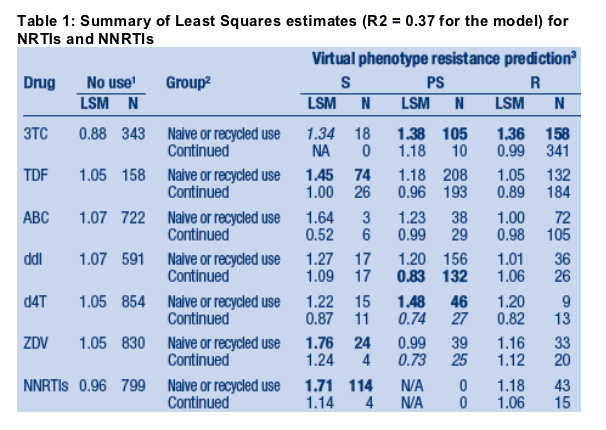
1 Least Squares Mean of the viral load reduction for patients who did not take the drug, adjusted for other drugs in the regimen. For example, an LSM of 0.75 indicates that, after adjusting for other drugs in the regimen, patients not taking the drug had an average viral load reduction of 0.75 log10.
2 Naive use = no previous record of taking that drug; Recycled = not on the drug at screening but had taken drug in past; Continued = taking drug at screening and continued into the trial.
3 S = Susceptible, PS = Partially Susceptible, R = Resistant, LSM = Least Squares Mean; Numbers in bold are statistically significant when comparing to not taking the drug (p<0.05), numbers in italic are borderline significant (0.05 < p<0.1).

1 Least Squares Mean of the viral load reduction for patients who did not take the drug, adjusted for other drugs in the regimen. For example, an LSM of 0.75 indicates that, after adjusting for other drugs in the regimen, patients not taking the drug had an average viral load reduction of 0.75 log10.
2 Naive use = no previous record of taking that drug; Recycled = Had taken drug in past.
3 LSM = Least Squares Mean; Numbers in bold are statistically significant when comparing to not taking the drug (p<0.05), numbers in italic are borderline significant (0.05 < p <0.1)

1 Least Squares Mean and N are for patients who were fully resistant to the randomized PI, adjusted for other drugs in the regimen. For example, an LSM of 0.75 indicates that, after adjusting for other drugs in the regimen, patients fully resistant to their PI had an average viral load reduction of 0.75 log10.
2 S = Susceptible, PS = Partially Susceptible, LSM = Least Squares Mean; Numbers in bold are statistically significant when comparing to the patients fully resistant to randomized PI (p<0.05), numbers in italic are borderline significant (0.05 < p<0.1). Numbers in red indicate a statistically significant difference between TPV/r and CPI/r.
Drug impact on response
For NRTIs, NNRTIs and enfuvirtide, drug impact on responses was calculated by subtracting the LSM for patients not taking the drug from the LSM for patients taking the drug. For PIs, the impact was taken to be the difference in LSMs for partially susceptible and susceptible TPV/r and CPI/r patients vs resistant PI patients. Estimates were rounded to the nearest 0.25 log10. Only estimates that were statistically significant or borderline significant that were determined
to increase viral load are shown - these are given a "positive" impact implying that they would be detrimental the viral load reduction. The results are presented below in Table 4.
As an example, for Resistant, Naive or Recycled 3TC, the LSM is 1.36 implying that patients, on average after adjusting for other drugs in the regimen, had a 1.36 log10 viral load reduction when taking naive or recycled resistant 3TC. The LSM for no 3TC use is 0.88 log10. Thus, drug impact = 1.36 - 0.88 = 0.48 ≡ 0.5 log10. For the PI impacts, notice that the LSM for susceptible TPV is 1.68 log10 and for resistant PI the LSM is 0.48 log10 (acts like no PI use). Thus, drug impact of TPV = 1.68 - 0.48 = 1.20 ≡ 1.25 log10.
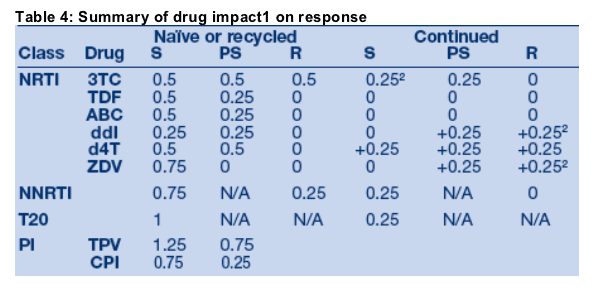
1 Drug impact estimates are the taken from Tables 1 and 2 as the LSM of response if in the drug use/resistance group minus the LSM response if not taken the drug. For PIs, the effect subtracts the LSM response for fully resistant PI to mirror a placebo-like response. Estimates are rounded to the nearest 0.25 log. Only detrimental response estimates are given if statistically significant (p<0.10).
2 No patients in these grouping so estimates "carried upward" or "downward" from the PS estimates depending if the drug is predicted to help or hurt virologic response.
Construction of a Background Activity Score (BAS) and relation to virologic response
Using the estimates in Table 4 for relation to week 8 response, we can determine for each patient the total predicted contribution to regimen response of the drugs in the OBR. This can be referred to as a Background Activity Score (BAS), to distinguish it from a GSS.
Tables 5 and 6 shows several examples of how the BAS is calculated for a specific patient. For example, in Table 5 it is shown that patient 1 received 3TC, d4T and TDF as an OBR and was randomized to receive LPV/r. This patient had a week 8 viral load reduction of 2 log10. In Table 6, more information is provided on the historical use and resistance to each drug in the OBR:
- 3TC - The patient was on resistant 3TC entering the trial. From Table 4, we see that this is predicted to provide no help to the regimen in terms of helping viral load reduction. This is indicated in parentheses that predicted activity is 0.
- TDF - The patient was partially susceptible TDF entering the trial. From Table 4, we see this patient is predicted to receive 0 log10 of support from continued, partially susceptible TDF.
- ddI - The patient was on partially susceptible ddI entering the trial. From Table 4, this is predicted to actually increase viral load by 0.25 log10.
- EFV - Previously used resistant EFV was added to the regimen. From Table 4, this is predicted to provide 0.25 log10 of support to the regimen.
- Thus, BAS = 0 + 0 + 0.25 - 0.25 = 0. This patient is predicted to be receiving no support from their background regimen. Thus, the viral load reduction of 2 can be wholly attributed to receiving fully susceptible TPV/r as their PI.
- Patient 1 provides a good example of where adjustments such as a Genotypic Sensitivity Score can be misleading. The partial susceptibility of ddI and TDF in the OBR lead to a GSS of 2 although the regimen really does not have the equivalent of 2 active drugs since these have been continued from the previous regimen.
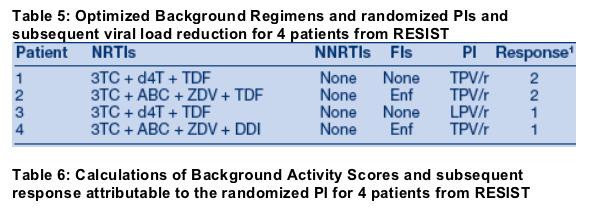
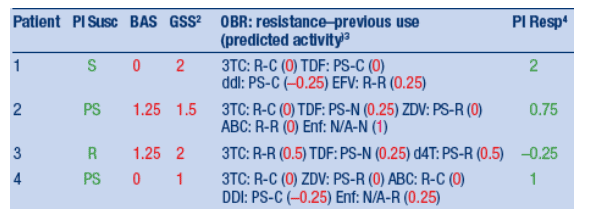
Footnotes for Tables 5 and 6
1 Response is the viral load reduction (i.e. a value of 2 means the patient had a 2 log10 viral reduction from baseline).
2 GSS = Genotypic Sensitivity Score: the number of drugs in the regimen likely to be active (PS or S for NRTIs and any use for
Enfuvirtide).
3 For each drug in the OBR, the resistance (R = Resistant, PS = Partially Susceptible, S = Susceptible) and treatment history (N = Naive,
R = Recycled, C = Continued) are provided.
4 PI Resp is the response attributable to the randomized Protease Inhibitor: PI Resp = Response - BAS.
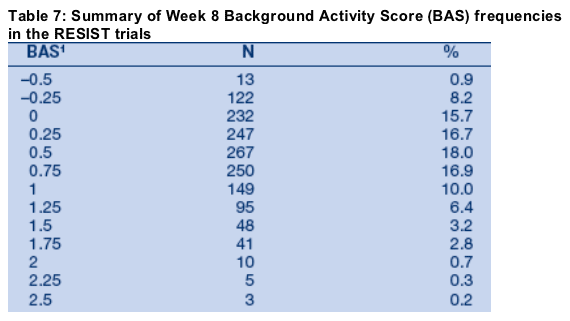
1 BAS can be interpreted as the predicted viral load reduction by the OBR. For example, a patient with a BAS of 0.5 can be expected to receive a 1/2 log10 reduction in viral load from their OBR. A BAS <0 indicates that the OBR is predicted to actually increase viral load.
Relationship to virologic response
Table 8 and Figure 1 show the week 48 virologic response rates (VL <50) and week 8 viral load changes from baseline by BAS groupings and randomized PI, further stratified by predicted PI susceptibility. Key results are:
- The background regimen cannot sustain a 48-week response without support from the PI, as evidenced by only 6/291 (2.1%) responders across all BAS groupings for resistant PI.
- With more than a half a log of background support, 40% (82/207) of TPV/r-susceptible patients achieved VL <50 at week 48 compared to only 21% (25/121) of CPI/r-susceptible patients (p<0.001).
- With sufficient background support (≥1 log), 37% (63/169) of patients with at least partial susceptibility to TPV/r achieved VL <50 at week 48, compared to only 26% (31/121) of CPI/r patients with at least partial susceptibility (p=0.042).
- TPV/r patients experienced greater week 8 viral load reductions and week 8 VL <50 independent of PI resistance and degree of background activity.
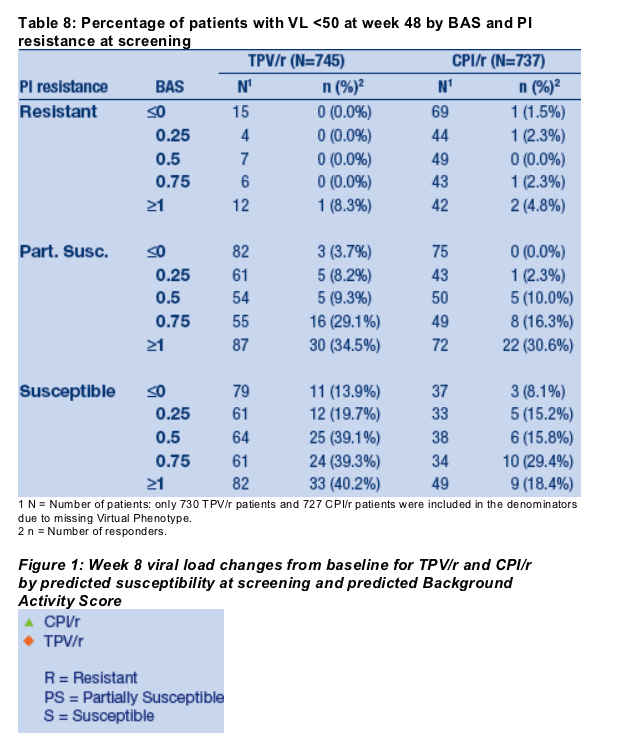
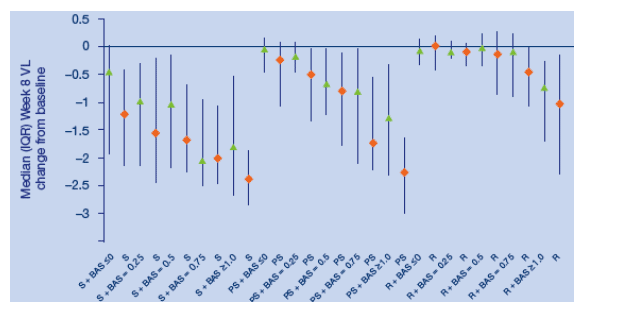
References
1. Maggiolo F, Airoldi M, Callegaro A, Ripamonti D, Gregis G, Quinzan G, Bombana E, Ravasio V, Suter F. Predictions of Virologic Outcome of Salvage Antiretroviral Treatment by Different Systems for Interpreting Genotypic HIV Drug
Resistance. Journal of the International Association of Physicians in AIDS Care: JIAPAC. 6(2):87-93, 2007 Jun
2. Scherer J, Boucher CA, Baxter JD, Schapiro JM, Kohlbrenner VM, Hall DB. Improving the prediction of virologic response to tipranavir: the development of a tipranavir weighted score. 11th European AIDS Conference / EACS, October 24 - 27 2007, Madrid, Spain (Poster # P3.4/07)
|
| |
|
 |
 |
|
|